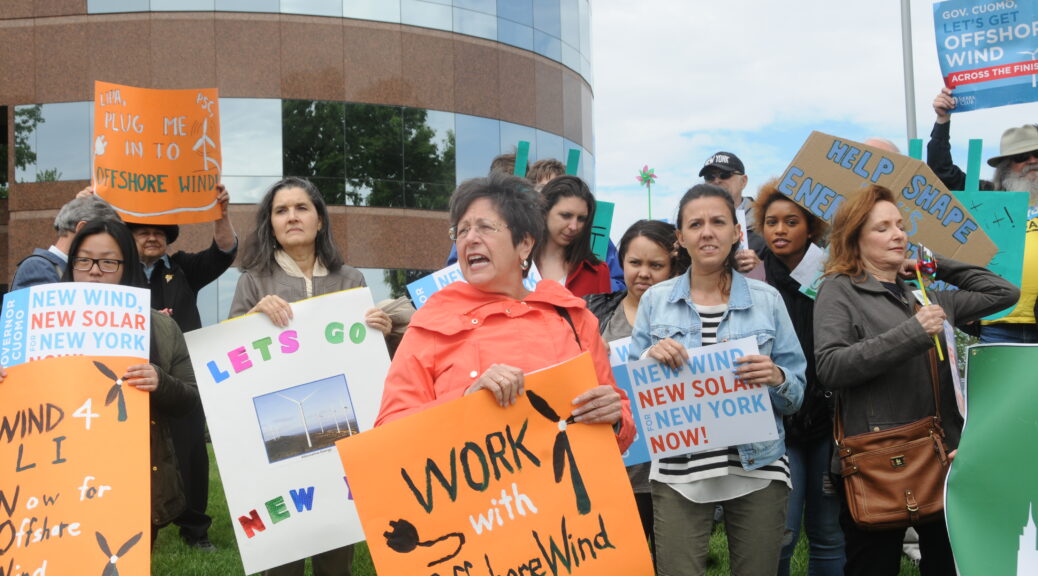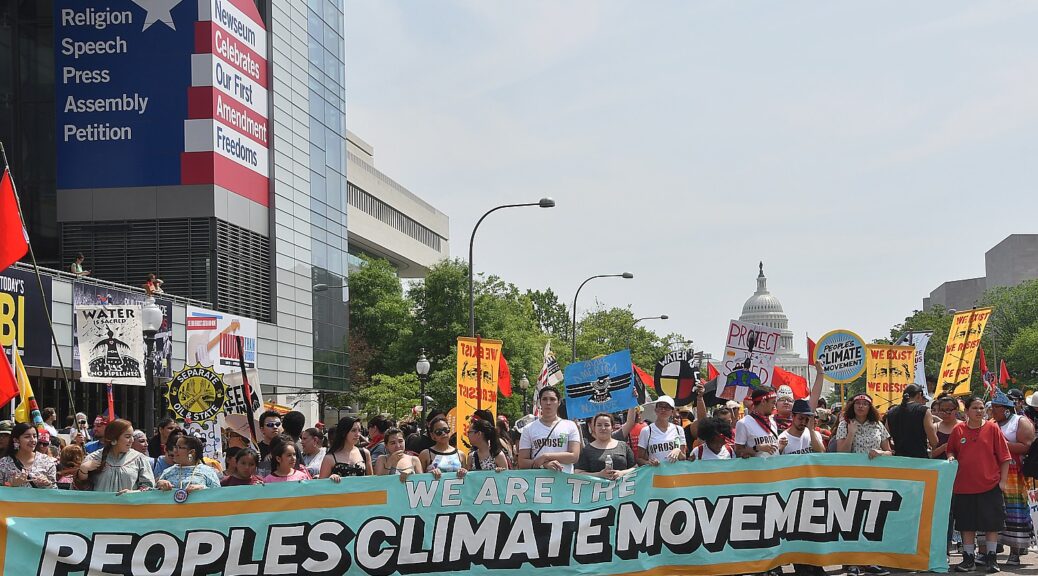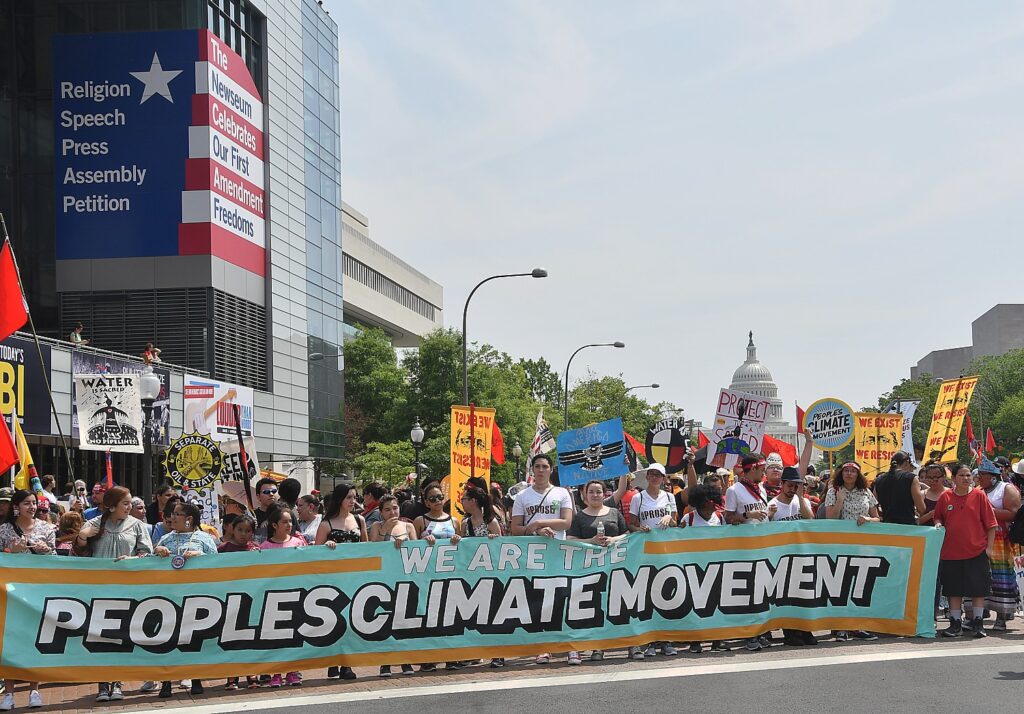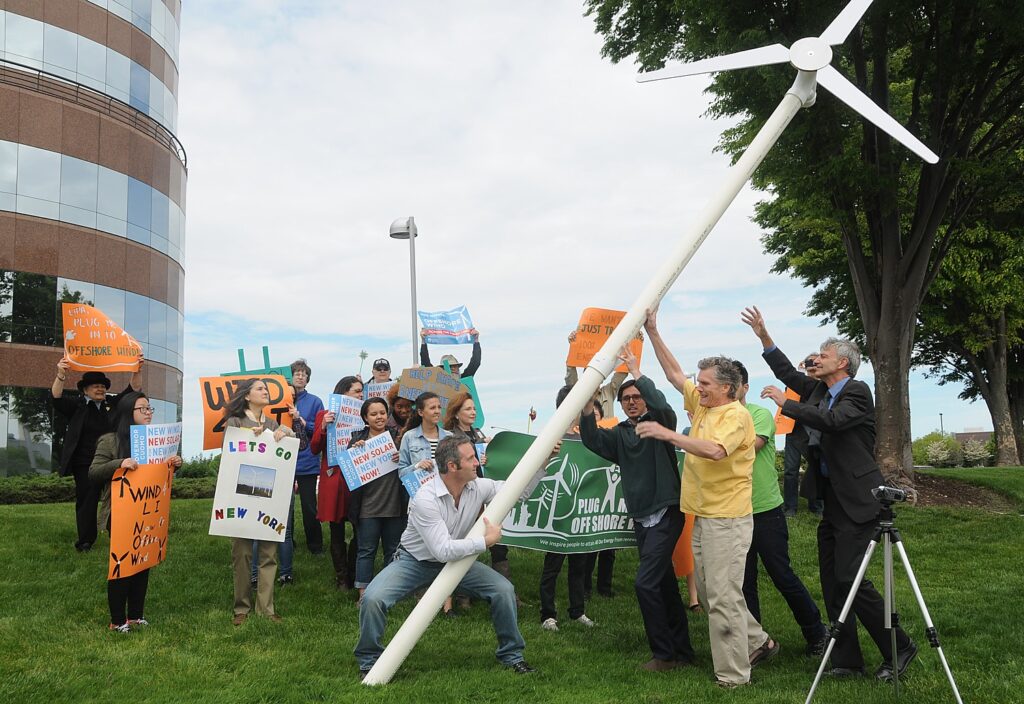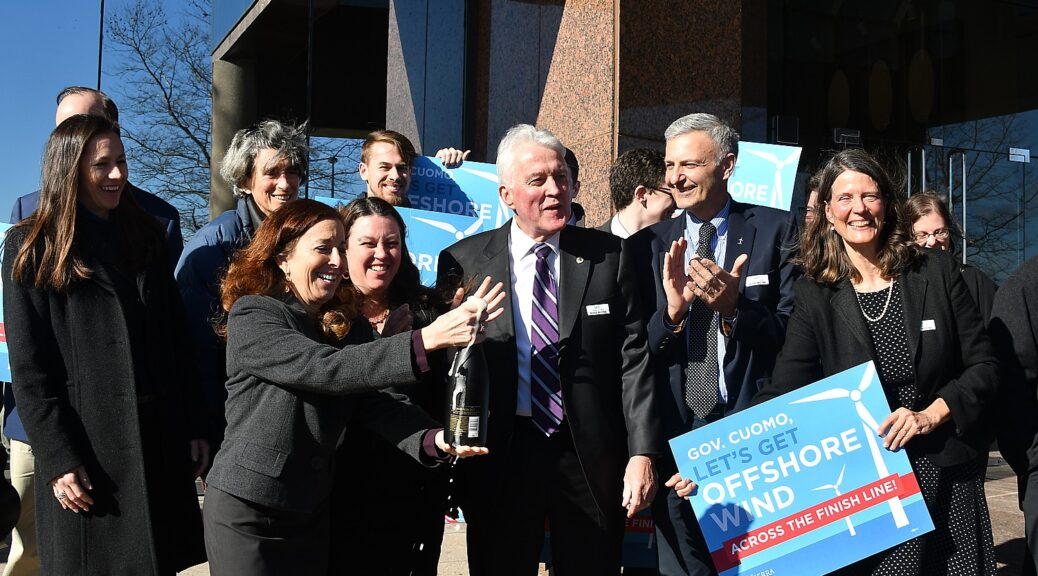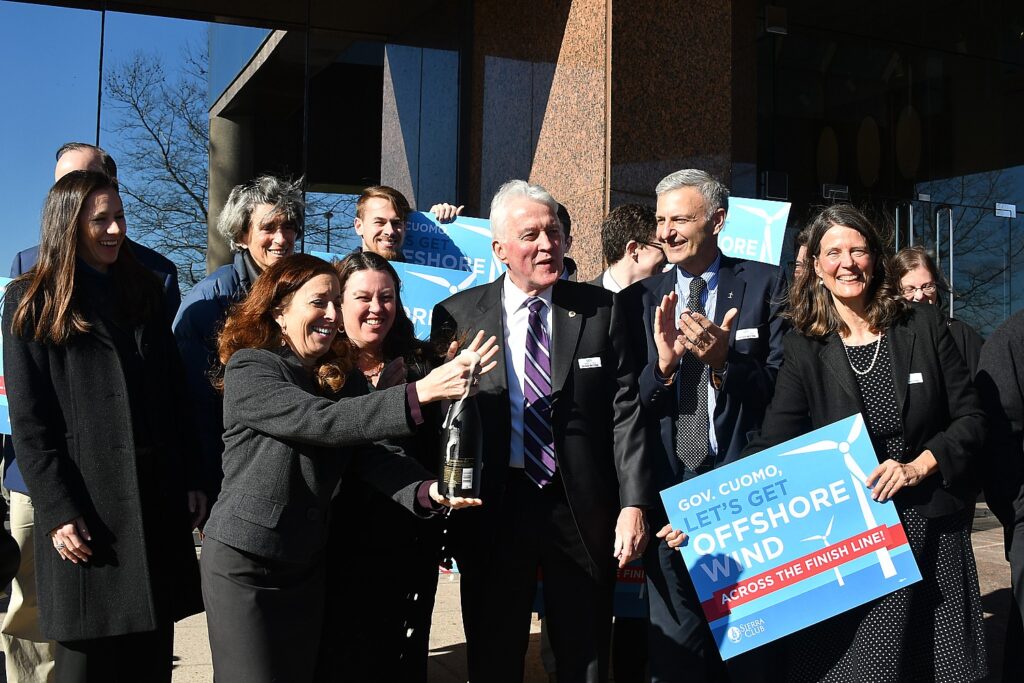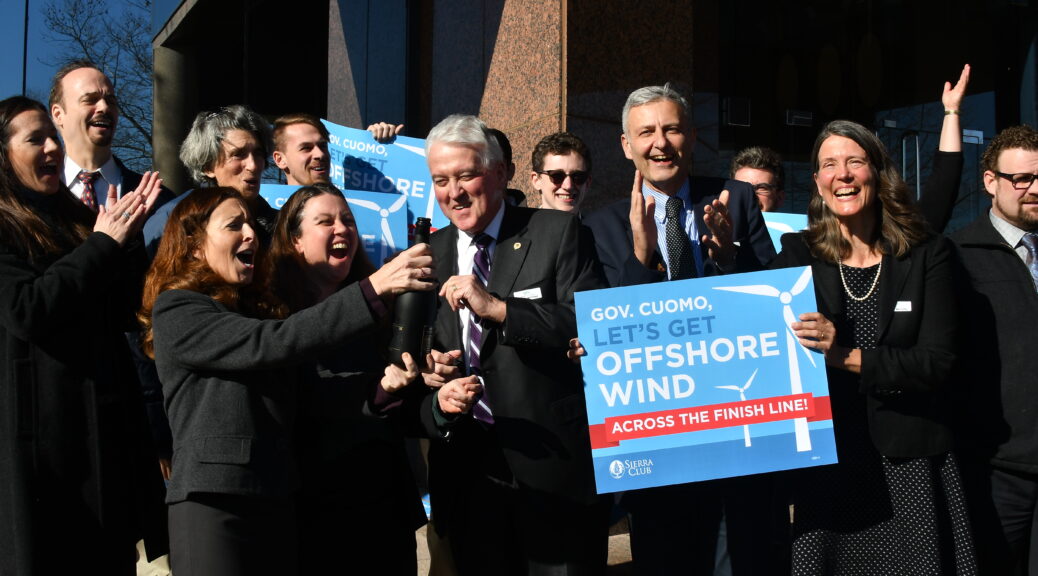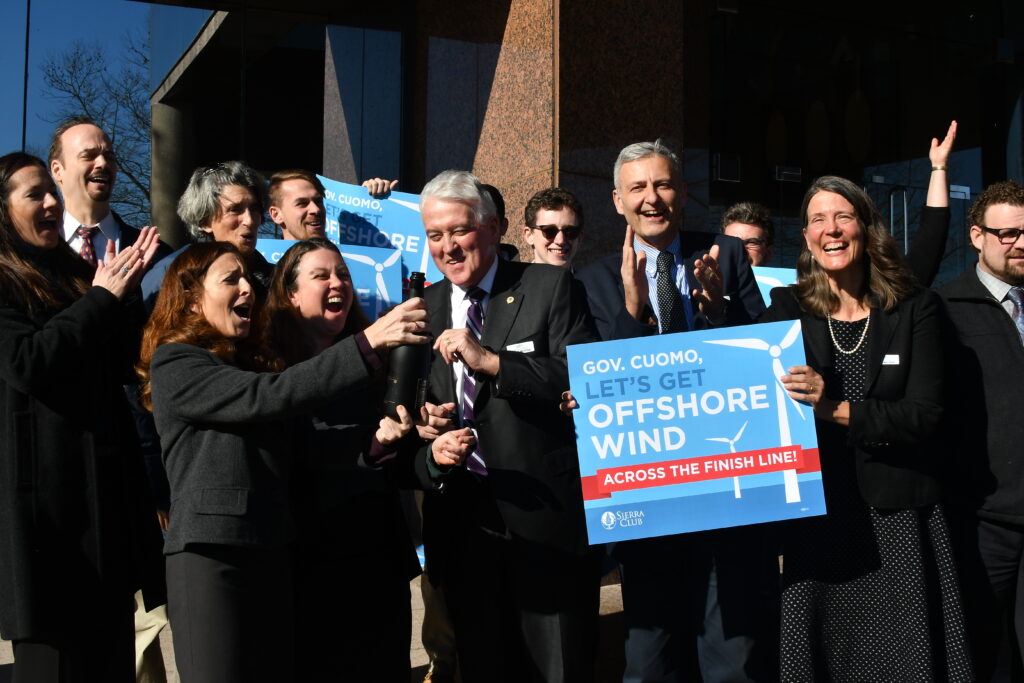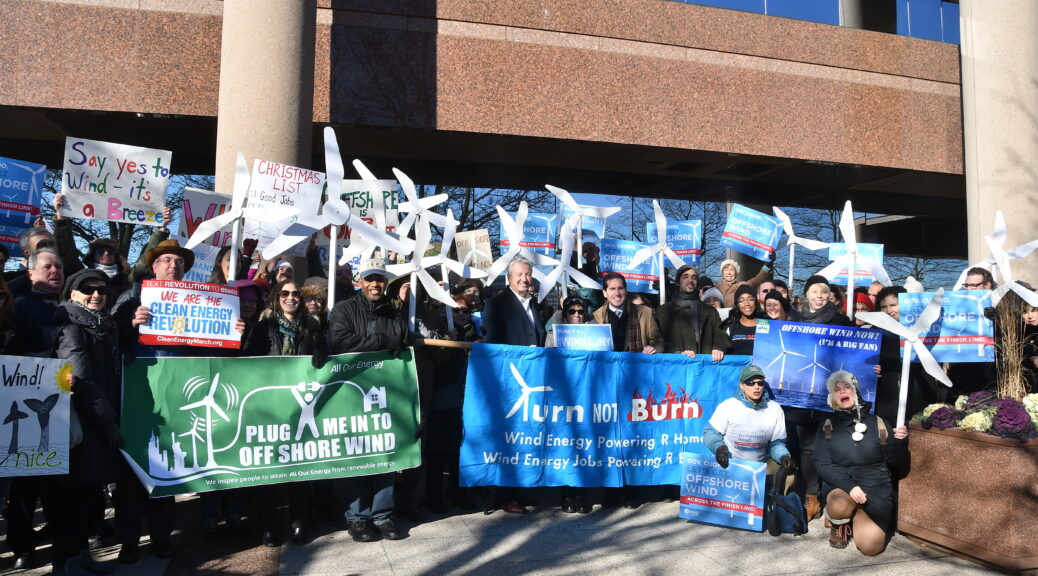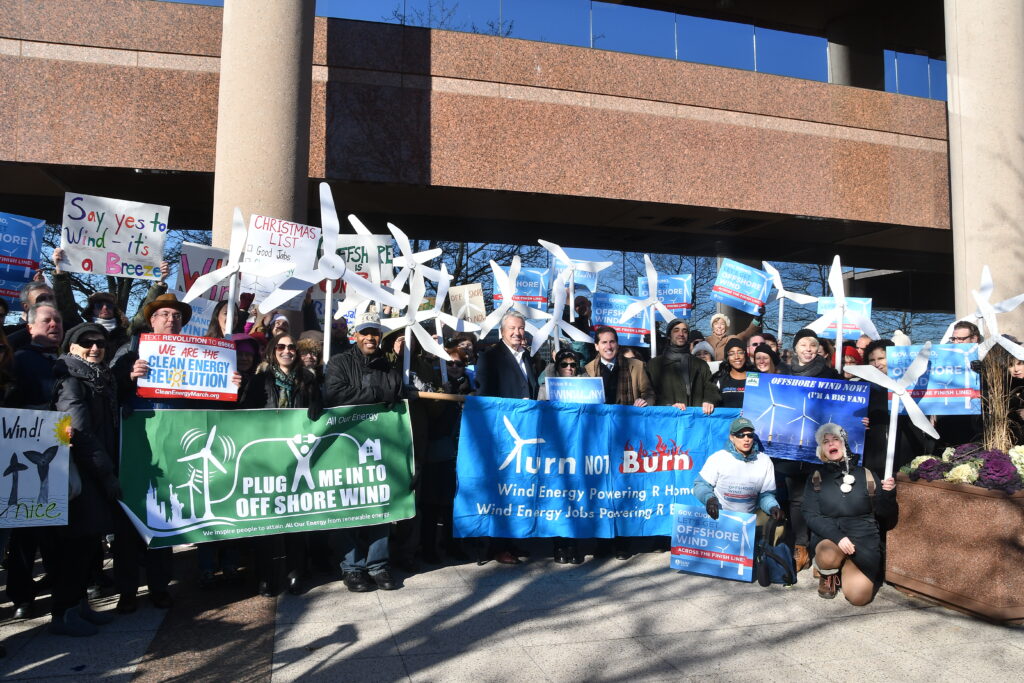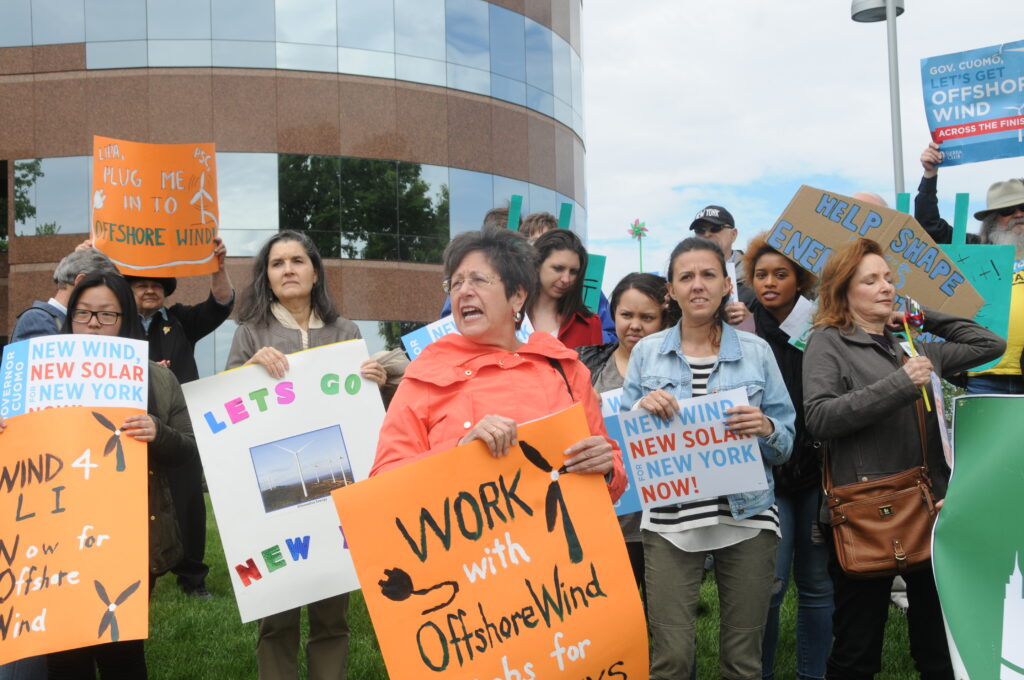
Three Offshore Wind and 22 Land-Based Renewable Energy Projects Totaling 6.4 Gigawatts Will Power 2.6 Million New York Homes and Deliver 12 Percent of New York’s Electricity Needs in 2030
Projects Expected to Create Approximately 8,300 Family-Sustaining Jobs and Bring $20 Billion in Economic Development Investments Statewide, Including Developer-Committed Investments to Support Disadvantaged Communities
Advances the Nation’s First Offshore Wind Blade and Nacelle Manufacturing Facilities with the State Committing $300 Million and Attracting an Additional $668 Million in Private Funding
Supports Progress Toward New York’s Climate Act Goal to Obtain 70 Percent of the State’s Electricity from Renewable Sources by 2030
79 Percent of New York’s 2030 Electricity Needs to be Met with Renewable Energy
Governor Kathy Hochul has announced the largest state investment in renewable energy in United States history, demonstrating New York’s leadership in advancing the clean energy transition. The conditional awards include three offshore wind and 22 land-based renewable energy projects totaling 6.4 gigawatts of clean energy, enough to power 2.6 million New York homes and deliver approximately 12 percent of New York’s electricity needs once completed. When coupled with two marquee offshore wind blade and nacelle manufacturing facilities, this portfolio of newly announced projects is expected to create approximately 8,300 family-sustaining jobs and spur $20 billion in economic development investments statewide, including developer-committed investments to support disadvantaged communities.
The announcement supports progress toward New York’s goal for 70 percent of the state’s electricity to come from renewable sources by 2030 – and nine gigawatts of offshore wind by 2035 – on the path to a zero-emission grid as required by the Climate Leadership and Community Protection Act. Following these awards, New York will now have enough operating, contracted, and under development renewable energy projects to supply 79 percent of the state’s 2030 electricity needs with renewable energy.
“New York continues to set the pace for our nation’s transition to clean energy,” Governor Hochul said. “An investment of this magnitude is about more than just fighting climate change – we’re creating good-paying union jobs, improving the reliability of our electric grid, and generating significant benefits in disadvantaged communities. Today, we are taking action to keep New York’s climate goals within reach, demonstrating to the nation how to recalibrate in the wake of global economic challenges while driving us toward a greener and more prosperous future for generations to come.”
U.S. Secretary of Energy Jennifer M. Granholm said, “The Department of Energy applauds the significant step that this announcement represents for building an offshore wind energy industry here in the U.S. that revitalizes domestic manufacturing and coastal economies, while advancing our clean energy future. New York is showing President Biden’s Investing in America agenda at work, and DOE looks forward to continued collaboration on project deployment, development of a robust domestic supply chain along with transmission development to help realize both our state and federal offshore wind goals.”
Once in service, the awarded offshore wind and land-based renewable energy projects will:
- Produce approximately 19 million megawatt-hours of new renewable energy per year, enough to power more than 2.6 million New York homes.
- Reduce greenhouse gas emissions by 9.4 million metric tons annually, the equivalent of taking more than 2 million cars off the road every year.
- Provide public health benefits resulting from reduced exposure to harmful pollutants—including fewer episodes of illness and premature death, fewer days of missed school or work, less disruption of business, and lower health care costs.
- Deliver a host of benefits to disadvantaged communities in line with the Climate Act goals, with over $3.5 billion in commitments to disadvantaged communities made by developers.
New York State Energy Research and Development Authority President and CEO Doreen M. Harris said, “This latest and largest round of large-scale renewable energy awards is further proof that New York is, and will continue to be, a place where the renewable energy sector can thrive. This cohort of large-scale renewable energy projects reflect New York’s longstanding and ongoing priority to responsibly advance the most cost-competitive and economically viable clean energy projects in a manner that is timely and maximizes benefits for all New Yorkers.”
Today’s announcement represents the first set of actions taken by the State as part of New York’s 10-point Action Plan, announced recently by Governor Hochul, offering insight into how the Governor’s Administration plans to overcome recent macroeconomic and inflationary challenges that have impacted the renewable energy sector. Today’s awards also mark the commencement of contract negotiations with the awarded parties, and the awards are conditional on successful contract execution.
Demonstrating the State’s commitment to ensuring these projects create quality, family-sustaining jobs for New Yorkers, the contracts upon full execution will include commitments to purchase certain minimum amounts of U.S. iron and steel and prevailing wage provisions for all laborers, workers, and mechanics performing construction activities. In addition, offshore wind project developers will be required to negotiate Project Labor Agreements among their construction contractors and a building and construction trade labor organization representing craft workers for the construction of the new renewable energy generation resources.
The Nation’s Largest-Ever State Investment in Offshore Wind
In the most competitive offshore wind solicitation in the U.S., NYSERDA has selected three new offshore wind projects totaling 4,032 megawatts (MW) of clean energy which is expected to displace over 7 million metric tons of CO2 annually, equivalent to removing 1.6 million cars from the road each year. Additionally, the awarded projects will bring more than $15 billion in anticipated in-state spending and create more than 4,200 family sustaining jobs across Long Island, New York City and the Capital Region over the 25-year lifespan of the projects.
The three offshore wind projects include:
- Attentive Energy One (1,404 MW) developed by TotalEnergies, Rise Light & Power and Corio Generation. The project includes a novel fossil repurposing plan in Queens, which seeks to retire fossil fuel power generation in the heart of New York City and transition the current workforce to clean energy jobs.
- Community Offshore Wind (1,314 MW) developed by RWE Offshore Renewables and National Grid Ventures. The project includes utilization of new grid interconnection being developed by Con Edison in downtown Brooklyn, made possible by the Public Service Commission Order Approving Cost Recovery for Clean Energy Hub to maximize delivery of clean electricity into New York City.
- Excelsior Wind (1,314 MW) developed by Vineyard Offshore (Copenhagen Infrastructure Partners). The project includes proposed cable route options providing robust energy deliverability to Long Island, leveraging the electric grid expansion provided through the Long Island Public Policy Transmission Need outcome.
Together, these projects will bring tremendous benefits to New York’s economy, workforce, and environment, including:
- More than $85 million to support wildlife and fisheries research, mitigation, and enhancement.
- Nearly $300 million in commitments to Minority and Women Owned Business Enterprises (MWBEs) and Service-Disabled Veteran Owned Businesses (SDVOBs).
- Over $100 million in commitments to train New York’s workforce to build and service offshore wind projects.
- Billions of dollars in public health benefits resulting from reduced exposure to harmful pollutants—including fewer episodes of illness and premature death, fewer days of missed school or work, less disruption of business, and lower health care costs.
These projects employ a mix of flexible and innovative transmission designs, including a reduced footprint in transmitting energy from offshore wind projects to New York City through high voltage direct current (HVDC) and adaptable “Meshed-Ready” offshore electrical substations. The three offshore wind projects are anticipated to enter commercial operation in 2030. The average bill impact for customers over the life of the projects will be approximately 2.73 percent, or about $2.93 per month. The average all-in development cost of the awarded offshore wind projects over the life of the contracts is $96.72 per megawatt-hour.
Delivering on Governor Hochul’s commitment to make New York State a hub for the U.S. offshore wind supply chain, this procurement includes continued support for offshore wind turbine manufacturing, which leverages over $2 in privately committed capital for every $1 of New York public funding.
NYSERDA is also awarding $300 million in state investment to enable the development of two supply chain facilities including nacelle manufacturing and assembly by GE Vernova, along with blade manufacturing developed by LM Wind Power Blades USA, both planned for New York’s Capital Region.
This investment has the capacity to supply almost one-third of the total regional demand for offshore wind by 2035, which will unlock $968 million in public and private funding, create 1,700 direct and indirect jobs backed by prevailing wage and project labor agreements, and result in over $3 billion in direct spending in the State. Additionally, these projects also align with available federal tax credits, enabling future savings to New York’s ratepayers.
New York’s Land-Based Renewable Energy Procurement
In addition, New York also announced its latest round of conditional land-based large-scale renewable awards, which are comprised of 14 new solar projects, six wind repowering projects, one new wind project, and one return-to-service hydroelectric project, totaling a combined 2,410 megawatts – enough new renewable generation to power over 560,000 New York homes annually for at least 20 years. These projects are expected to spur over $4 billion in direct investments and create over 4,100 good-paying short- and long-term jobs across New York State.
The projects by region include:
Central New York
- Oxbow Hill Solar: Cypress Creek Renewables will build a 140-megawatt solar facility in the Town of Fenner, Madison County.
Finger Lakes
- Gravel Road Solar: Delaware River Solar will build a 128-megawatt solar facility in the Towns of Tyre and Seneca Falls, Seneca County.
- Hatchery Solar: VC Renewables, LLC will build a 19.99-megawatt solar facility in the Town of Caledonia, Livingston County.
- SunEast Hampton Corners Solar: Cordelio Power will build a 19.99-megawatt solar facility in the Town of Groveland, Livingston County.
- SunEast Niagara Solar: Cordelio Power will build a 19.99-megawatt solar facility in the Town of Caledonia, Livingston County.
- White Creek Solar, LLC: AES will build a 135-megawatt solar facility in the Towns of York and Leicester, Livingston County.
- Hemlock Ridge Solar: AES will build a 200-megawatt solar facility in the Towns of Barre and Shelby, Orleans County.
- Valcour Bliss Windpark: AES will repower a 100.5-megawatt wind facility in the Town of Eagle, Wyoming County.
- Valcour Wethersfield Windpark: AES will repower a 126-megawatt wind facility in the Town of Wethersfield, Wyoming County.
Mohawk Valley
- Dolgeville Hydro: Energy Ottawa NY Generation Ltd. will continue operations for a 5-megawatt hydroelectric facility in the Town of Dolgeville, Herkimer County.
- SunEast Millers Grove Solar: Cordelio Power will build a 19.99-megawatt solar facility in the Town of Schuyler, Herkimer County.
North Country
- North Country Wind: Terra-Gen Development Company, LLC will build a 298.2-megawatt wind facility in the towns of Burke and Chateaugay, Franklin County.
- Riverside Solar: AES will build a 100-megawatt solar facility in the Towns of Lyme and Brownville, Franklin County.
- SunEast Morris Solar: Cordelio Power will build a 19.99-megawatt solar facility in the Town of Gouverneur, St. Lawrence County.
- Valcour Altona Windpark: AES will repower a 97.5-megawatt wind facility in the Town of Altona, Clinton County.
- Valcour Chateaugay Windpark: AES will repower a 106.5-megawatt Wind facility in the Town of Chateaugay, Franklin County.
- Valcour Clinton Windpark: AES will repower a 100.5-megawatt Wind facility in the Town of Clinton, Clinton County.
- Valcour Ellenburg Windpark: AES will repower an 81-megawatt Wind facility in the Town of Ellenburg, Clinton County.
Southern Tier
- Clear View Solar: VC Renewables, LLC will build a 19.99-megawatt Solar facility in the Town of Cohocton, Steuben County.
- Stonewall Solar: Nexamp will build a 145-megawatt solar facility co-located with 20 megawatts of energy storage in the Town of Meredith, Delaware County.
Western New York
- Somerset Solar: Somerset Solar, LLC will build a 125-megawatt solar facility in the Town of Somerset, Niagara County.
Outside of New York
- Mineral Basin Solar: Swift Current Energy will build a 401.6-megawatt solar facility in the Townships of Girard and Goshen, Clearfield County, Pennsylvania, and will deliver energy into the New York electric grid.
The average bill impact for customers over the life of the projects will be approximately 0.31 percent, or about $0.32 per month. The average all-in development cost of the awarded Tier 1 projects over the life of the contracts is $60.93 per megawatt-hour. Importantly, these projects are prioritizing benefits to disadvantaged communities in line with the State’s Climate Act, with over $108 million in commitments to disadvantaged communities made by developers as part of their proposals to NYSERDA. These projects are also expected to result in over $38 million in commitments in spending to MWBEs and SDVOBs.
The State will continue to emphasize and enhance engagement with the communities where the projects are being developed. NYSERDA offers resources and no-cost technical assistance to help local governments understand how to manage responsible clean energy development in their communities, including step-by-step instructions and tools to guide the implementation of clean energy, including permitting processes, property taxes, siting, zoning, and more.
Long Island Power Authority Chief Executive Officer Thomas Falcone said, “LIPA proudly stands with Governor Hochul as we make history with this monumental investment in renewable energy. These projects are part of a shared commitment to a sustainable future, directly aligning with LIPA’s vision of delivering clean, reliable, and affordable electricity to our communities. Governor Hochul is transforming how we power New York while creating thousands of jobs in a new industry.”
“New York’s significant investments in offshore wind and renewable energy projects are a testament to Governor Hochul’s commitment in advancing a clean energy economy while reducing greenhouse gas emissions to benefit the state’s communities,” New York State Department of Environmental Conservation Commissioner Basil Seggos said. “I applaud the Governor for continuing to address the challenges of climate change with the wind, solar, and hydro projects announced today that are helping ensure a greener, more prosperous, and equitable future for all New Yorkers.”
New York State Department of Labor Commissioner Roberta Reardon said,“Under Governor Hochul’s leadership, this monumental investment not only propels New York to the forefront of the renewable energy sector but promises thousands of family-sustaining jobs across our state. As we work towards a sustainable future, we’re committed to ensuring that every New Yorker reaps the economic benefits of this initiative, especially our disadvantaged communities.”
Representative Paul Tonko said, “I have always believed in the potential for New York to play a leading role in offshore wind and clean energy development and have pushed hard at the federal level to advance policy and investment that grows out this industry. Today’s announcement is a realization of that vision. This next chapter in the storied history of skilled labor and innovation in our area will bring hundreds of good paying green jobs to the Capital Region while advancing our clean energy future and protecting our environment for generations to come. I look forward to closely working with our state and commercial partners to make these bold plans a reality and I will never stop working to secure our clean energy future and create the jobs of tomorrow.”
“Today marks a key milestone for solar, wind and renewable energy projects that will not only help New York reach its sustainability goals, but also create thousands of good paying, union careers for our hardworking tradesmen and tradeswomen,” New York State Building Trades President Gary LaBarbera said. “This historic investment will brighten our clean energy future and the improve the lives of all New Yorkers, including those who will now have the opportunity to work on these projects, support their families and pursue a more accessible path to the middle class. We applaud Governor Hochul for her continued commitment to streamlining clean energy initiatives, all while uplifting working class New Yorkers.”
New York State AFL-CIO President Mario Cilento said, “I thank Governor Hochul for this historic investment that will help us combat climate change, and ultimately win that battle while creating solid, middle-class, union jobs right here in New York State. It is the next step to ensuring that New York’s clean energy future is built, operated, and maintained by a highly trained and highly skilled union workforce. We look forward to continuing to work with the governor to address climate change while creating and preserving family-sustaining union jobs.”
Long Island Federation of Labor, AFL-CIO President John Durso said, “We look forward to working with the governor and her team as we move the offshore wind industry forward, creating good union jobs that will not only power Long Island’s economy but also make an historic commitment to our environment. The Long Island Federation of Labor, as a crucial partner, plays a pivotal role in ensuring the success of offshore wind development, with our expertise and dedication, in bolstering the growth of the industry while safeguarding the interests of our workforce.”
“Today’s announcement is clearly indicative of Governor Hochul’s intent to move forward with a thriving offshore wind industry,” IBEW Local Union #3 Business Manager Christopher Erikson said. “This commitment includes labor protections for working men and women, the guaranteeing of good wages, the inclusion of PLA’s and workforce development for both the construction trades and supply chain employers. This is good for New Yorkers, our employers, our environment, and the health of generations to come.”
Alliance for Clean Energy New York Executive Director Anne Reynolds said, “New contracts for 22 wind, solar, and hydroelectric projects, plus for three major offshore wind energy projects, is good news for New York’s environment and electricity system. Building these projects will mean construction jobs for laborers, electricians, and other building trades, as well as cleaner air for New Yorkers. The renewable energy industry welcomes today’s announcements and looks forward to continuing to work with the state of New York on its ambitious energy transition.”
New York Offshore Wind Alliance Director Fred Zalcman said,“Today’s announcement by the Governor, awarding three contracts for more than 4,000 MW of offshore wind generation, shows that New York is prepared to double down on this clean, renewable and job-creating resource, and will go a long way towards instilling confidence in a market that has recently faced tremendous headwinds.
New York League of Conservation Voters President Julie Tighe said, “As the climate crisis bears down on us and the health of our population and planet continue to suffer the damaging effects of burning fossil fuels, we can no longer afford to just talk about renewable energy, we need to deliver real projects on the ground. The awarding of an additional 6.2 GW of wind, solar, and hydro power is a big step to meeting the state’s renewable energy goals and a major win for public health and the environment. We applaud Governor Hochul and NYSERDA President Doreen Harris for going big in the latest round of renewable energy procurements.”
Citizens Campaign for the Environment Executive Director Adrienne Esposito said, “Climate change impacts have continued to assault New York this year with more flooding in New York City subways, mud slides in Westchester and significant erosion along Fire Island and Long Island’s south shore. Now is the time to act! Transitioning to renewable energy is the primary action we need to take to fight climate change. Today’s announcement establishes a pivotal turning point in advancing green energy in our state. We are excited and hopeful that New York will lead the way for our Nation to act just as vigorously and decisively as New York. We applaud Governor Hochul and NYSERDA for this historic action which will not only fight climate change, but also result in cleaner air, healthier communities and uplift our economy.”
President of the Building and Construction Trades Council of Nassau and Suffolk Counties, and President of the National Offshore Wind Training Center Matthew Aracich said,”Here is another shining example by Governor Hochul honoring her pledge to advance the offshore wind industry here in NY. The magnitude of these projects will undoubtedly spur economic growth that will reverberate throughout the state and simultaneously provide a true pathway to the middle class. The work mentioned in today’s announcement allows skilled labor’s registered apprenticeship training programs to grow at an unprecedented rate and holds the key to maintaining a vibrant future for the Long Island Region. When we build green energy projects at a scale necessary, we eliminate our dependence on fossil fuels as quickly as possible.”
New York State’s Nation-Leading Climate Plan
New York State’s nation-leading climate agenda calls for an orderly and just transition that creates family-sustaining jobs, continues to foster a green economy across all sectors and ensures that at least 35 percent, with a goal of 40 percent, of the benefits of clean energy investments are directed to disadvantaged communities. Guided by some of the nation’s most aggressive climate and clean energy initiatives, New York is on a path to achieving a zero-emission electricity sector by 2040, including 70 percent renewable energy generation by 2030, and economywide carbon neutrality by mid-century. A cornerstone of this transition is New York’s unprecedented clean energy investments, including more than $55 billion in 145 large-scale renewable and transmission projects across the state, $6.8 billion to reduce building emissions, $3.3 billion to scale up solar, more than $1 billion for clean transportation initiatives, and over $2 billion in NY Green Bank commitments. These and other investments are supporting more than 165,000 jobs in New York’s clean energy sector in 2021 and over 3,000 percent growth in the distributed solar sector since 2011. To reduce greenhouse gas emissions and improve air quality, New York also adopted zero-emission vehicle regulations, including requiring all new passenger cars and light-duty trucks sold in the State be zero emission by 2035. Partnerships are continuing to advance New York’s climate action with nearly 400 registered and more than 100 certified Climate Smart Communities, nearly 500 Clean Energy Communities, and the State’s largest community air monitoring initiative in 10 disadvantaged communities across the state to help target air pollution and combat climate change.

